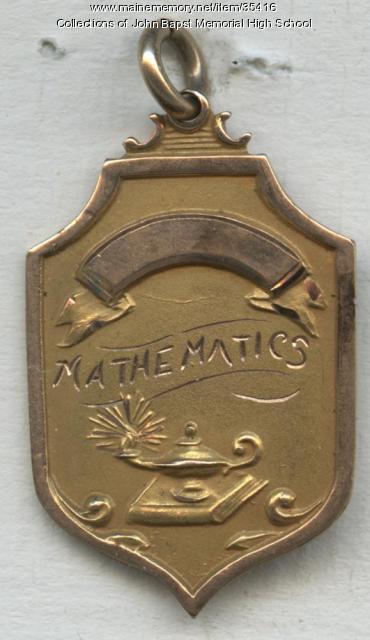Keywords: achievement
Item 35416
John Bapst High School Academic Pin for Mathematics, Bangor, 1929
Contributed by: John Bapst Memorial High School Date: 1929 Location: Bangor; Orrington Media: Metal
Item 37384
Front page of World War II Award, Lubec, 1944, 1944
Contributed by: Lubec Historical Society Date: 1944 Location: Lubec Media: Ink on paper
Exhibit
Maine's first governor, William King, was arguably the most influential figure in Maine's achieving statehood in 1820. Although he served just one year as the Governor of Maine, he was instrumental in establishing the new state's constitution and setting up its governmental infrastructure.
Exhibit
George F. Shepley: Lawyer, Soldier, Administrator
George F. Shepley of Portland had achieved renown as a lawyer and as U.S. Attorney for Maine when, at age 42 he formed the 12th Maine Infantry and went off to war. Shepley became military governor of Louisiana early in 1862 and remained in the military for the duration of the war.
Site Page
View collections, facts, and contact information for this Contributing Partner.
Site Page
Historic Clothing Collection - 1830-1850 - Page 3 of 3
"… smooth over the chest to waist, an appearance achieved by inserting batting between lining and outer fabric."
Story
One View
by Karen Jelenfy
My life as an artist in Maine.
Story
Aurore Morin & Huguette Paquette: immigrating to Biddeford
by Biddeford Cultural & Heritage Center
The experience of a young mother and her teenage sister making the transition from Quebec to Maine.
Lesson Plan
Grade Level: 9-12
Content Area: Social Studies
Maine's quest for statehood began in the years immediately following the American Revolution. Though the state of Massachusetts consented to the separation in 1819 and Maine would ultimately achieve statehood in 1820, Maine’s split from Massachusetts was not without controversy and was not universally supported by people living in Maine. Using primary sources, students will explore the arguments for and against Maine statehood. Students will gather evidence and arguments to debate the statement: It is in the best interests of the people of Maine for Maine to become its own state.
Lesson Plan
Grade Level: 3-5, 6-8, 9-12
Content Area: Social Studies, Visual & Performing Arts
"In the four quarters of the globe, who reads an American book?" Englishman Sydney Smith's 1820 sneer irked Americans, especially writers such as Irving, Cooper, Hawthorne, and Maine's John Neal, until Henry Wadsworth Longfellow's resounding popularity successfully rebuffed the question. The Bowdoin educated Portland native became the America's first superstar poet, paradoxically loved especially in Britain, even memorialized at Westminster Abbey. He achieved international celebrity with about forty books or translations to his credit between 1830 and 1884, and, like superstars today, his public craved pictures of him. His publishers consequently commissioned Longfellow's portrait more often than his family, and he sat for dozens of original paintings, drawings, and photos during his lifetime, as well as sculptures. Engravers and lithographers printed replicas of the originals as book frontispiece, as illustrations for magazine or newspaper articles, and as post cards or "cabinet" cards handed out to admirers, often autographed. After the poet's death, illustrators continued commercial production of his image for new editions of his writings and coloring books or games such as "Authors," and sculptors commemorated him with busts in Longfellow Schools or full-length figures in town squares. On the simple basis of quantity, the number of reproductions of the Maine native's image arguably marks him as the country's best-known nineteenth century writer. TEACHERS can use this presentation to discuss these themes in art, history, English, or humanities classes, or to lead into the following LESSON PLANS. The plans aim for any 9-12 high school studio art class, but they can also be used in any humanities course, such as literature or history. They can be adapted readily for grades 3-8 as well by modifying instructional language, evaluation rubrics, and targeted Maine Learning Results and by selecting materials for appropriate age level.















